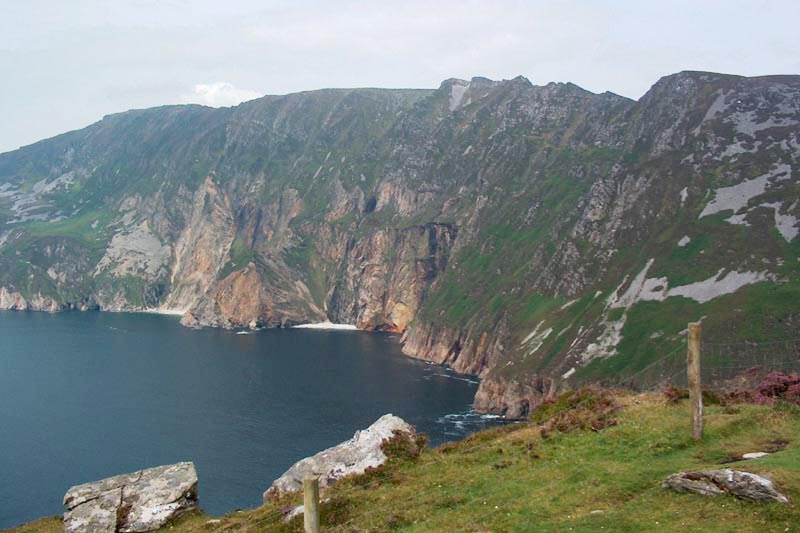I headed west and north across Ireland in July for a few days with my son Ivor. It was a golf expedition as we do not fish or hunt. Ivor wanted badly to visit Sliabh Liag or Slieve League in English. Sliabh Liag is a mountain on the northwest coast along the Wild Atlantic Way of Ireland. It forms a sheer cliff carved out of thin-bedded Dalradian quartzites just over 600 metres metres high above the Atlantic ocean and it is one of the highest sea cliffs in Europe. The wind buffeted and as I tired to get out of my car a violent gust almost lifted the driver-door of my car off its moorings. The violent wind had wrench-strained the door out of alignment. I drove back down the windying cliff road with one hand to steer and one hand to keep the car door from flapping open. . We got back to the little village of Carrick snuggled on the hinterland of the lower Glen River valley. It took the weight of three men to strain the dented car door back into rough alignment so that I could close it. A high technology solution – at least to get me back to Dublin.
It all reminded me of a poem by the late Seamus Heaney called Postscript. “As big soft buffetings come at the car sideways and catch the heart off guard and blow it open”. This wild beauty is far from the gloom in the mining sector and the typhoon in the Chinese stock markets. Falling metal and equity prices reminded me of the fault lines which run through our world. Fault lines in sudden seismic shifts which displace people and dislocate economies. “You are neither here nor there, A hurry through which known and strange things pass.”
This was a week when the global economy quaked from an epicentre in China. It had extreme impact and a rare event. It was not a Black Swan because it was not completely unpredictable. We try to find simple explanations for these events but the reality is complex. Everything interconnected, cascading events and domino effects beyond our comprehension and ability to predict.
The Chinese middle class is as big as the whole population of the United States. Is it catching the personal-debt disease? In China borrowing to buy stocks in a bull market, if you can, is a gamble to provide security in old age. In China the legacy of the one-child law has resulted in great dependency. Often two parents and four grandparents depend on a youngster’s future. The lack of a social net in China also makes it different from the West. Is it little wonder that they are such big savers in China? Attempts to replace an export-driven economy with domestic demand will need spending not saving. Fundamental changes must happen and it will not be overnight.
There are just over two weeks of supply in zinc warehouses around the world. In the past this level of inventory has resulted in a price spike. Uncertainty about long term Chinese demand for metals is overriding supply – demand fundamentals. Mines are closing and we are not making new discoveries. It will be how aware we are of emerging supply deficits which will boost zinc and other metals prices. This will only happen when we reach calm waters or when the deficit becomes acute.
Vedanta is closing the Lisheen zinc mine in County Tipperary and selling the plant. It was the 11th largest zinc mine in the world at one stage. I worked there as an exploration geologist between 1992 and 1993. It was exciting as the team drilled out resources and discovered new mineralised zones. . The discovery drill hole at Lisheen cut massive sulphides in 1990 and the mine opened in 1999. That is just under ten years from discovery to production.
I had a quick look around at a small sample from a small group of junior zinc explorers and miners. The idea of even seven to ten years from discovery to production only relates is unusual. More often it takes many attempts over generations to chip out a profitable mine from a flawed and challenged project. Many do not make it but be wary of those that are still trying.
In 1928 prospectors discovered Prairie Creek zinc project in the Northwest Territories of Canada. There was little further work until 1966 when Cadillac Resources acquired the property. During the next 25 years Penarroya did some work. A 1,200tpd copper concentrator arrived on site. The Bunker-Hunt brothers became involved and assisted with financing. By 1982 and with US$64 million spent the project was almost ready to go into modest production at 500tpd. Then the silver price collapsed. The Company went into receivership and assets were tied up in litigation until 1990. In 1991 Canada Zinc optioned the property from Conwest Exploration Company Ltd. In 2001 a scoping study for re development of the mine was completed. Prairie Creek is still not in production.
Platinova discovered the Citronen Fjord zinc deposit in northern Greenland in 1993. Platinova teams mapped, surveyed and drilled during the summer of 1993 to 1997. Platinova paid for over 33,000 metres of diamond drilling in 143 holes. Ironbark Zinc Limited (Ironbark) acquired the Citronen Project in early 2007. Citronen is still not a mine.
Trevali Mining acquired Caribou in 2012. Between 2006 and 2008 the previous operator invested $100 million and went into production. It lasted 13 months. Metal prices collapsed in 2008 as part of the fallout of the global financial crisis. I was underground at the Pomerzany zinc mine in October of 2008 when the zinc price was at 58 cents per lb. Anaconda Minerals owned the Caribou property between 1954 and 1987. Trevali is currently commissioning a new mine at Caribou.
An Exploration joint venture discovered the McIlvenna Bay zinc deposit in 1988. In November 2014 Foran Mining released results of a preliminary economic assessment (PEA). The PEA was positive. It is twenty six years since the initial discovery. McIlvenna bay is still not a mine.
Canada Zinc Metals Akie deposit was first staked in 1978. Around 1992 Inmet discovered a high-grade outcrop running 18.8 percent zinc and lead. Drilling by Inmet between 1994 and 1996 led to the building of a 12 million tonne resource. The resource had grades of 8.6% zinc, 1.5% lead and 17g/t silver. In 2005, Canada Zinc Metals acquired a 65% interest in the Akie property from Ecstall Mining. Canada Zinc Metals acquired the whole project through the takeover of Ecstall Mining. To date economics on the development of a new mine are not available.
There are many good reasons why exploration projects take a long time to develop into mines. Some say it is the seventh explorer who gets the prize. There are new insights and new technologies new mineralised zones discovered. But a long project history may point to challenges which are difficult to solve. The gap between discovery and development may be a proxy for a high project-difficulty-index. Investor be ware. When the zinc price spikes be careful about what comes out of the wood-work. “New” projects may have been around for a long time.
If the four zinc project mentioned above were all to go into production it would probably add no more than 300,000 tonnes of zinc to global mine supply. With the closure of Lisheen and Century this year over 400,000 tonnes of zinc will be lost. In 2013 these two mines together produced over 600,000 tonnes of zinc in concentrate. World mine production was just over 13 million tonnes of zinc in 2014. There is not much coming down the pipeline as mine supply is whittled away.
In mineral exploration you lose money daily in the hope of a big win. This is something we are hard-wired to avoid. We are it seems more willing to risk loss than to risk a gain. Kahneman and Tversky conducted a simple experiment to prove this behaviour. It has huge ramifications for investors. In the first case a group of people received $300 and asked to pick between a sure gain of $300 and a gamble on the flip of a coin. The gamble was heads you get $200 and tails you lose. Most of the group opted for the sure gain. In the second case they got $500 at the start and had to choose between losing $100 and a gamble on flipping a coin to win or lose $200. In this case most of the group avoided the sure loss and took the gamble. Both experiments are identical from a probability perspective but how it seems how they are framed is crucial.
Small daily wins in the stock market are addictive. It is so addictive that we are blind to losing it all in a crash. It takes a real contrarian to flip this on its head. To do this you need an option call which makes a lot of money if the market suddenly swings and goes into an air pocket. These options cost money and most of the time nothing too dramatic happens. Your lose daily in the hope of a big win. Anyone following this contrarian investment strategy should have made a great deal of money this week.
Read an essay by Malcolm Gladwell called Blowing Up about risk and Nicholas Taleb and the concept of the Black Swan or just read Taleb’s book if you are inclined.
Postscript
And some time make the time to drive out west
Into County Clare, along the Flaggy Shore
In September or October, when the wind
And the light are working off each other
So that the ocean on one side is wild
With foam and glitter, and inland among stones
The surface of a slate-grey lake is lit
By the earthed lightening of flock of swans
Their feathers roughed and ruffling, white on white,
Their fully-grown headstrong-looking heads
Tucked or cresting or busy underwater.
Useless to think you’ll park or capture it
More thoroughly. You are neither here nor there
A hurry through which known and strange things pass
As big soft buffetings come at the car sideways
And catch the heart off guard and blow it open
– by Seamus Heaney


Thanks Alan for letting me know.
Cheers
John
Thank you John, really enjoyed reading that. Your blogs are terrific.
Alan